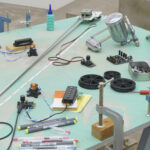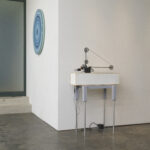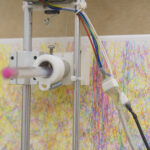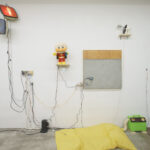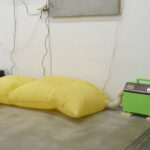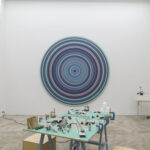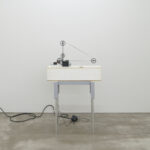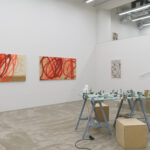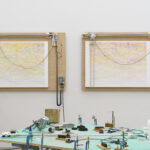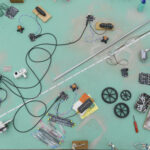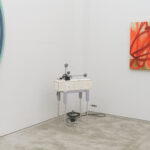Exhibition
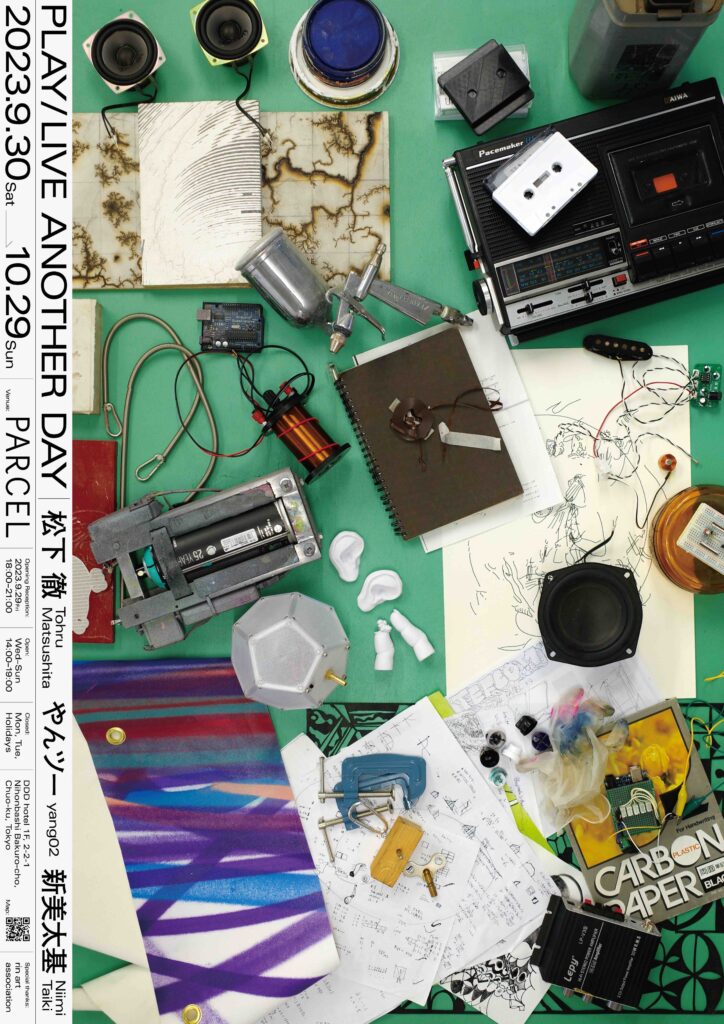
Past
2023
09.30Sat
10.29Sun
PARCEL
Open on Wed - Sun
14:00 - 19:00
Closed on Mon, Tue, National Holidays
Opening reception on September 29th Fri 18:00-21:00
PLAY / LIVE ANOTHER DAY
Tohru Matsushita / yang02 / Taiki Niimi
details - JP
この度PARCELでは松下徹、やんツー、新美太基の3名によるグループ展「PLAY/LIVE ANOTHER DAY」を開催いたします。松下は塗料の化学変化や特性を用いたシリーズや、高電圧の軌跡を利用した作品など、オートマチックにつくり出す図柄を観測・操作・編集するプロセスにより絵画作品を制作しております。やんツーは「描く」や「鑑賞する」など行為の主体をロボット/機械などの外的要因に委ねることで表現の主体性を問う作品を数多く制作してきました。新美は楽曲制作と共に、音楽プレーヤーや楽器などを自主制作した音響インスタレーション作品を制作。様々なアーティストやミュージシャンの音響や展示制作をサポートすることを活動とし、近年では∈Y∋(BOREDOMS)の新プロジェクトFINALBY( )のメンバーとして、フジロックフェスティバル‘21に参加しております。
少し前のオーディオプレーヤーを見ると、▶︎のボタンに「PLAY/再生」と刻印されています。かつてジョンケージはレコードについて「景色を台無しにしてしまう絵葉書」、または音楽体験を殺してしまうものとしていくつかの議論で触れています。しかし日本語の翻訳でPLAYを再生=再び生きると書かれており、つまり記録媒体のデータは蘇り、毎回新しい命を与えることができるのです。これは日本語翻訳の歪みについての指摘ですが、実際に▶︎が持つ機能と意味は、時代ごとに変化しています。
例えば、音楽のサブスクリプションサービスは楽曲の▶︎に関して新たな状況が生み出されており、アーティストのアルバムより、DJの編集された視点が楽曲との出会いを決め、音楽を再生することはプレイリストを再生することに等しくなりつつあります。またYOUTUBEのアイコンは▶︎ですが、ショート動画の躍進によって、▶︎ボタン自体の存在が消えつつあるのです。そしてNETFLIXのヒットドラマ「Black Mirror」では、鑑賞者にストーリーの分岐点を選択させ、物語が変化します。もはや▶︎は約束された一定の体験をもたらすのではなく、新しい時間と空間を誕生させる為の記号と考えられるのでは無いでしょうか。
今回展示する3人のアーティストは、音楽の作曲やコンピューターによるプログラミング、スプレーを用いた塗装などテクニカル/インダストリアルな方法で作品を制作しています。3名は共通して「動きを繰り返すシステムやルール」を作品制作のプロセスに利用していますが、同時に「結果がずれていく仕組み」が設定されており、非再現性を制作の中で重要視しています。延々にコピーアンドペーストできるデータに囲まれて日々生活している私たちにとって、多くの事象に再現性があり、一過性の出来事に出会うことの方が難しいと感じます。かつてボードリヤールは、オリジナルなきコピーで消費世界が形成されてことをシュミラクルと呼びましたが、データはプレーヤー(再生機)の進化/変化や、聞き手の時代的な感性によって変化するのです。今回の展示では、このような「システムと偶然性」をテーマとし、ノイズや即興性など、予測すること/予測できないことを作品の中で実験するアーティスト達の展覧会になります。
details - EN
PARCEL is delighted to present the group exhibition “PLAY/LIVE ANOTHER DAY,” featuring the works of three artists: Tohru Matsushita, yang02, and Taiki Niimi. Matsushita creates his paintings through a process of observing, manipulating, and editing patterns generated automatically. His series often utilizes the chemical changes and properties of paint, as well as the trajectories of high-voltage currents. yang02 questions the subjectivity of artistic expression by entrusting the role of the “artist” or “observer” to external factors such as robots and machines. He has produced numerous works that explore this theme. Taiki Niimi, in addition to composing music, creates sound installation pieces featuring self-made music players and instruments. His projects include supporting various artists and musicians in sound production and exhibition creation. Notably, he has recently been a member of the new project FINALBY( ) by ∈Y∋(BOREDOMS) and participated in the Fuji Rock Festival in 2021.
Looking at audio players in Japan from a little while ago, you’ll find the button marked with ▶︎ engraved as “PLAY/再生” (Play/Reproduction).
John Cage once referred to vinyl records as “postcards that ruin the scenery” or something that kills the experience of music in several discussions. However, the Japanese translation renders PLAY as 再生 (reproduction), implying that the data on the recording medium revives, capable of bestowing new life each time. This points out the distortion in the Japanese translation. However in reality, the functions and meanings held by ▶︎ have been changing with each era.
For instance, music subscription services have created new contexts around the ▶︎ of songs. Rather than an artist’s album, the edited perspective of a DJ determines the encounter with the music, blurring the line between playing music and playing a playlist. Additionally, while the icon for YouTube is ▶︎, the rise of short videos is causing the presence of the ▶︎ button itself to fade away. In the hit Netflix series “Black Mirror,” viewers are prompted to choose branching points in the story, altering the course of the narrative. The ▶︎ button no longer merely delivers a predetermined experience but could be thought of as a symbol birthing new time and space, as demonstrated in the show’s interactive episodes.
The three artists presented in this exhibition create their works using technical/industrial methods such as composing music, computer programming, and spray-paint application. While all three employ a common approach of incorporating “systems and rules that repeat motion” in their creative process, they also establish mechanisms where “deviation in outcomes” is introduced, emphasizing non-reproducibility within their creations. Amidst our daily lives surrounded by endlessly replicable data, we often encounter reproducibility in many events, finding it more challenging to come across transient occurrences. Once, Baudrillard referred to the formation of a consumer world through copies without originals as “Simulacra,” but data is subject to change due to the evolution/variation of players (playback devices) and the temporal sensibilities of listeners. This exhibition revolves around the theme of “systems and randomness,” showcasing artists who experiment with elements like noise and improvisation within their works, exploring predictability and unpredictability.
展覧会、各作家、作品等に関するお問い合わせはcontact@parceltokyo.jp までお願いいたします。
For further information regarding this exhibitions or the artists, artworks please contact us at contact@parceltokyo.jp
Tohru Matsushita | 松下 徹
アーティスト/SIDE CORE ディレクター
1984 年神奈川県生まれ
東京藝術大学先端芸術専攻修了
化学実験や工業生産の技術によって絵画作品を制作。高電圧の電流によるドローイング、塗料の科学変化を用いたペインティングなど、システムが生み出す図柄を観測・操作・編集するプロセスにより絵画作品を制作。またストリートカルチャーに関する企画を行うアートチーム SIDE CORE のディレクターの 1 人でもあり、国内外のストリートカルチャーに関するリサーチ/執筆をおこなっている。
Artist, SIDE CORE director
Born in 1984, Kanagawa pref. Japan
MA, Intermedia Art, Tokyo University of the Arts
Matsushita, creates paintings using techniques from chemical experiments and industrial production. His artwork is produced through a process of observing, manipulating, and editing patterns generated by systems, including drawing with high-voltage electrical currents and utilizing the scientific changes in paint. He also serves as one of the directors of the artist collective SIDE CORE, which curates projects related to street culture, and conducts research and writing on street culture both domestically and internationally.
yang02 | やんツー
1984 年、神奈川県生まれ。美術家。
多摩美術大学大学院 美術研究科 デザイン専攻 情報デザイン研究領域 修了
多摩美術大学 美術学部 情報デザイン学科情報芸術コース 卒業
セグウェイが作品鑑賞する空間や、機械学習システムを用いたドローイングマシンなど、今日的なテクノロジーを導入した既成の動的製品、あるいは既存の情報システムに介入し、転用/誤用する形で組み合わせ構築したインスタレーション作品を制作する。先端テクノロジーが持ちうる公共性を考察し、それらがどのような政治性を持ち、社会にどう作用するのか、又は人間そのものとどのような関係にあるか、作品をもって批評する。
Born in Kanagawa Prefecture in 1984.
yang02 graduated with a masterʼs degree in Information Design (Media Art) from Tama Art University in 2009.His works show how information technology can substitute human actions in the form of autonomous devices. Through digital media, his practice inquires into human physicality and the independence of oneʼs actions or expression.
Taiki Niimi | 新美 太基
楽曲制作と共に、音楽プレーヤーや楽器などを自主制作した音響インスタレーション作品を制作。またプログラミングや装置の製作などを通し、様々なアーティストやミュージシャンの音響や展示制作をサポートすることを活動とし、近年では∈Y∋ (BOREDOMS)の新プロジェクト FINALBY( )のメンバーとして、フジロックフェスティバルʻ21 に参加。また SIDE CORE のプロジェクトにおいてReborn-Art Festival(2022)に参加している。
In addition to music composition, Niimi creates sound installations, including self-made music players and instruments. He is also actively involved in programming and device fabrication, providing support for various artists and musicians in sound production and exhibition creation.
In recent years, Niimi has been a member of the new project FINALBY( ) by ∈Y∋ (BOREDOMS) and participated in the Fuji Rock Festival in 2021. Furthermore, he has contributed to the projects by Japanese artist collective SIDE CORE, participating in the Reborn-Art Festival in 2022.

